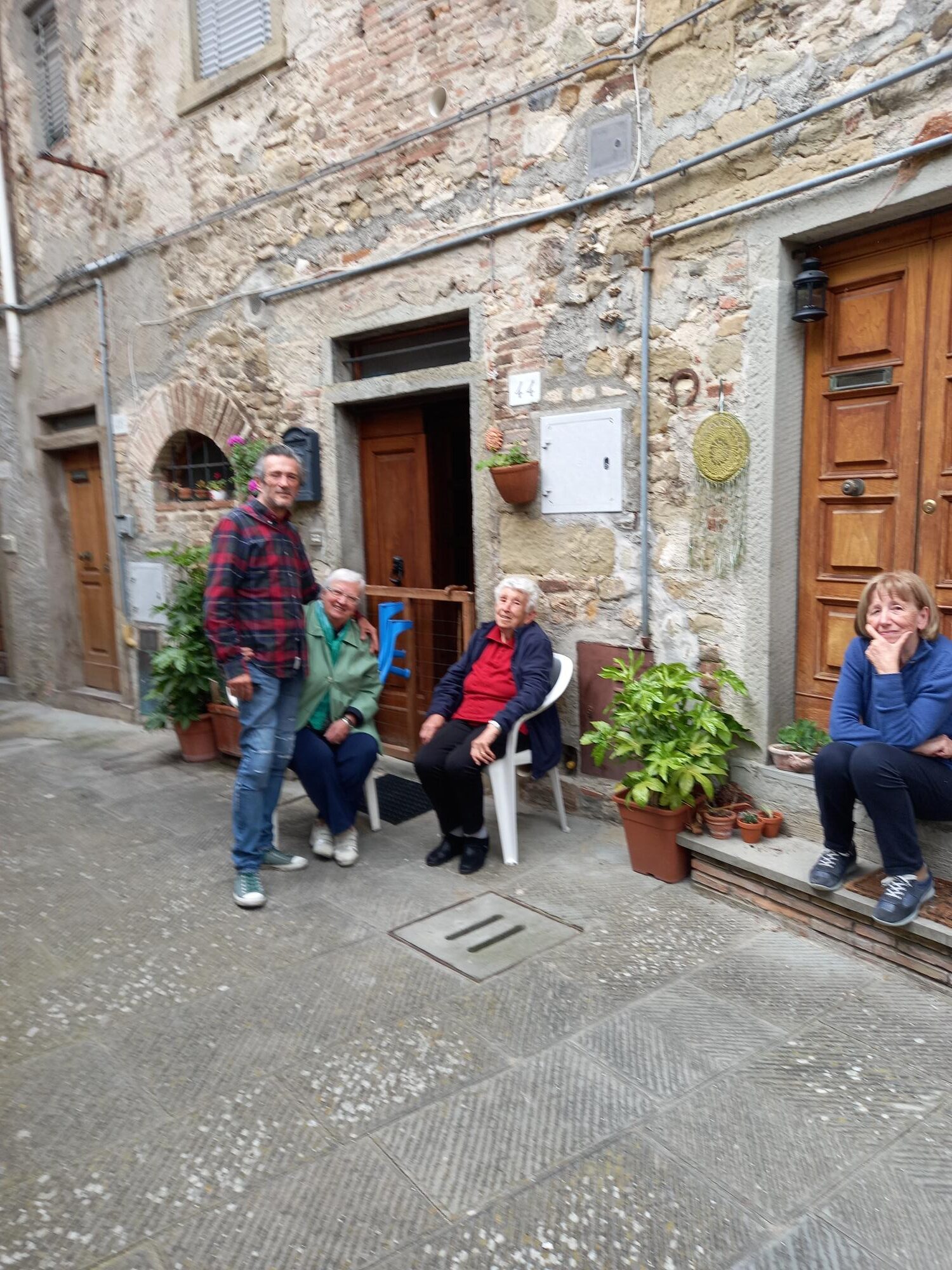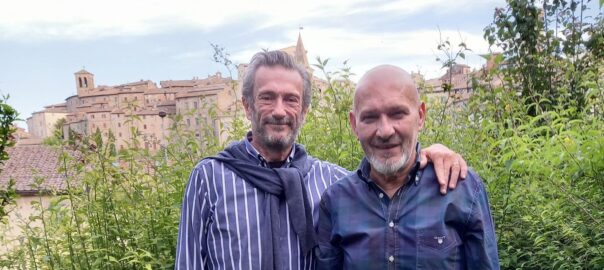In spring this year, I returned to Anghiari for the first time since Covid. While I was there, I interviewed several people on life in Anghiari during that period. These interviews will be published in both languages.
Vita ad Anghiari durante il Covid – Carlo Rossi
Quest’anno, in primavera, sono ritornata ad Anghiari per la prima volta dopo il Covid. Mentre ero là ho intervistato parecchie persone su come è stata la vita nel borgo in quel periodo.
Questa è l’intervista con Carlo Rossi che avevo già intervistato nel 2017 Belonging in Anghiari: Carlo Rossi. Carlo continua a dipingere e ha il suo atelier nel quartiere medievale di Anghiari, ma negli ultimi 5-6 anni ha anche gestito, con una collega, il negozio Busatti a Sansepolcro. L‘intervista si è svolta in italiano ed è poi stata trascritta e tradotta in inglese da Mirella Alessio. Questa è una versione editata.
Le foto: Carlo e Armando nel loro giardino; Carlo con le mie vicine.
È stato pesante, molto pesante, perché le notizie arrivavano dai mezzi di comunicazione e noi si vedeva cosa stava succedeva al nord, dove è iniziato a Milano, Bergamo. Alla prima espansione non sapevamo a cosa andavamo incontro, noi da qui vedevamo queste immagini con i camion con i morti. Da noi, la situazione era diversa perché viviamo all’interno della catena montagnosa dell’Appennino centrale. Il Covid ha colpito di più le città al nord e quelle più grandi come Roma e Napoli. Però le zone più protette sono rimaste quelle interne e più montagnose, logicamente, hanno meno abitanti. Però anche da noi è arrivato, non ricordo bene, nel ’20. Prima del primo lockdown si sentiva di una famiglia, stanno male, l’altra famiglia. Si stava a casa ad aspettare che la cosa finisca.
A me, personalmente, non è stato poi un così grande sacrificio stare in casa, forse anche perché abbiamo la fortuna, io e Armando, di avere un giardino molto, molto grande, dove possiamo muoverci anche se non si può andare fuori. Potevi stare a 200 metri da casa, fare una passeggiata intorno a casa, solo per portare a spasso il cane, per esempio. Noi abbiamo fatto il pranzo di Pasqua con una coperta, in giardino, davanti a Anghiari. Il pranzo di Pasqua, io Armando e Spillo. Meglio di così!
Il silenzio, soprattutto la sera, la sera perché… beh anche il giorno comunque, passavano le autoambulanze, c’era questo rumore ti faceva ricordare cosa stava succedendo. Per il resto, il cielo blu così pulito, non l’avevo mai visto, blu intenso. L’aria era migliore, la visibilità era migliorata, non c’era quella patina di sporco che viene con l’attività umana, le fabbriche tutte chiuse. Anche la natura ha ripreso un pochino in quel periodo.
Ad Anghiari tutti i negozi, i ristoranti, tutti chiusi. C’era soltanto aperto il negozio di alimentari e di frutta, e la farmacia. Quindi noi andavamo lì a fare la spesa con la mascherina, un po’ strano. Anche se noi si è un po’ esagerato con le precauzioni, si disinfettava tutto, le scatolette, e si metteva a posto. Però alla fine, in questo senso, qui del mangiare per me non è stato così tanto un problema. Noi abbiamo chiuso il negozio dove lavoro per più o meno 3 mesi, 3 volte, forse 4, non ricordo. Mentre tutto era chiuso si viveva con le sovvenzioni statali, per molti è stato difficile, specialmente se c’era un solo stipendio.
Ad Anghiari sono morte solo due o tre persone. Molti erano molto malati, in terapia intensiva, gli ospedali erano impreparati e non sapevano come agire finché non è arrivato il vaccino. Ma all’ospedale di Sansepolcro non c’è stata una situazione disastrosa come al nord.
Per me è stata una grossa mancanza non poter abbracciare le persone. Io sono abituato ad abbracciare amici, una persona che conosci; se incontri un amico l’abbracci, siamo più concreti che nelle grandi città. È stata forse una delle cose più faticose di non poter abbracciare neanche un fratello, un amico… ognuno ha la sua famiglia, la sua identità, è stata un po’ una mancanza. Ora, io sono ritornato come prima, io sono sempre quello. Ora, diciamo, è quasi tutto tornato normale.
La chiusura è stata strana perché Anghiari è un posto aperto, le persone sono molto amichevoli. Arrivando qua a casa tua ho incontrato la tua vicina, mi ha riconosciuto, è amica della mia mamma, una mia amica, sono tutte persone valide, in gamba, anche i giovani. Provo un grande amore per questo paese, vorrei che tutti provassero questo sentimento, così le cose andrebbero molto meglio.
Da due anni sta tornado un po’ anche le persone giovani, vengono ad abitare ad Anghiari vecchio. Prima c’erano finestre chiuse, anche in inverno, di varie età, non solo i vecchi, ritornano al paese. È stato il Covid a far svuotare un po’ le città e a riempire un po’ i centri in campagna. Molti, chi era a Milano e aveva la casa qui son venuti qui, non son rimasti a Milano. Un buon effetto del Covid: tanta gente ha ripreso a ricercare la natura, a fare la campagna, anche fuori di Roma, Milano si sono distaccati dalla città. Anche alcuni giovani che vengono da Anghiari stanno ritornando qui.

Voglio guardare al futuro in un modo migliore, speriamo.
Ann e Mirella
Life in Anghiari during Covid – Carlo Rossi
In spring this year, I returned to Anghiari for the first time since Covid. While I was there, I interviewed several people on life in Anghiari during that period.
Here is an interview with Carlo Rossi, who I previously interviewed in 2017. Belonging in Anghiari: Carlo Rossi. He continues to paint and still has his studio in the mediaeval part of Anghiari, but, for the past 5-6 years he has been working in the Busatti shop in Sansepolcro, which he now co-manages. The interview was conducted in Italian, and kindly transcribed and translated into English by Mirella Alessio. This is an edited version.
Photos: Carlo and Armando in their garden; Carlo with my neighbours.
It was (pesante) tough, very tough, because news arrived through the media, and we saw what was happening in northern Italy, where Covid started, in Milan, Bergamo. At the beginning we didn’t know what we were getting into; on tv, we only saw the military trucks carrying coffins (from Bergamo) to other towns for cremation. Here, the situation was different because we live in the central part of the Apennine mountain chain. The cities with the biggest numbers of Covid cases were in northern Italy, and Rome, Naples. Villages in the interior, in the hills and up in the mountains were more protected. It makes sense because they are less populated. It did arrive here too, I can’t remember very well when, in ’20. We heard of different families with sick people before the first lockdown. We stayed at home waiting for it to finish.
For me personally, staying at home was not such a big sacrifice, perhaps because Armando and I are lucky to have a very big garden where we could move about even if we couldn’t go outside the property. You were only allowed to go for a stroll around the house for a radius of 200 metres, to take out the dog, for example. We ate Easter lunch in the garden sitting on a blanket with the view of Anghiari in front of us. That was our Easter lunch: Armando and I, and our dog, Spillo. Could it get better than that?
But, oh, that eerie silence, especially in the evening, because in the evening, well actually even during the day, the sound of sirens of passing ambulances reminded us of what was happening. And then there was the blue of the clean sky – I have never seen such an intense blue. The air quality, the visibility, improved, there wasn’t that layer of dirt that comes from human activities – all factories were closed. Nature recovered a bit in that period.
In Anghiari, all shops, restaurants, were closed. Only the alimentari and the pharmacy were open. We went shopping with a mask, which was a bit strange. Perhaps we exaggerated with precautions – we disinfected all containers before putting them away in the kitchen shelves. But, in the end, getting foodstuff, for me at least, wasn’t such a big problem. We closed the shop where I work for more or less for 3 months, 3 times, perhaps 4 times, I don’t remember. While everything was closed, we lived on state benefits – for many it was difficult, especially if there was only one income.
In Anghiari, only 2 or 3 people died. Many were very sick, in intensive care; hospitals were unprepared and didn’t know what to do, until the arrival of vaccinations. But, at the Sansepolcro hospital the situation wasn’t such a disaster as in northern Italy.
What I missed the most was not being able to hug people. I am used to hugging friends, acquaintances – if you meet a friend, you hug them; in small towns it is like that, we all embrace each other, we are more physical than in big cities. It was perhaps one of toughest things, (faticoso), not being able to hug, not even a brother, a friend… we all have a family, an identity – something was missing. Now, I have gone back to being what I was before, I am still the same person. Now, let’s say, all is quite normal.
The closure of the town was strange as Anghiari is such an open place, people are very friendly. Arriving here at your house today I met your neighbour, she recognised me, she is one of my mother’s friends, a friend of mine, they are all good, capable people, the young ones too. I feel an intense love for this town, and I would love it if everyone could experience this feeling so things would be better.
Over the last 2 years, people have started coming back to live in this old part of town, in Anghiari vecchio. Before, windows were closed; now, even in winter, people of all ages are coming back to town. During Covid, people left big cities and moved to places in the countryside. Those who lived in Milan and had a house here didn’t stay in Milan, they came here. This is a positive effect of Covid – many looked again for somewhere immersed in nature, somewhere to cultivate the land. Some young people originally from Anghiari are coming back here too.
I want to look to the future in a positive way. Let’s hope.
Ann and Mirella
